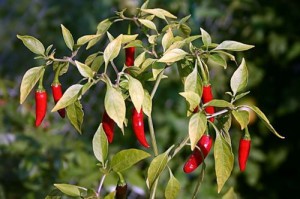Hot Pepper (Capsicum frutescens ), Tabasco Plant and also known as Siling Labuyo in the Philippines is a plant bearing very hot medium-sized oblong peppers. The fruits of most varieties are red, some are yellow, purple or black. The fruits are very pungent. The flowers are greenish white or yellowish white. Hot Peppers are considered as vegetables or spices for culinary purposes and is used generally as a condiment. Hot peppers contain phytochemicals known collectively as capsaicinoids which is safe and effective analgesic agent in the management of arthritis pain, herpes zoster-related pain, diabetic neuropathy, postmastectomy pain, and headaches. Its extracts also used to control borers and other larval insects.
Production of Hot Pepper

Varieties
- Matikas – long, tapering, smooth, dark green fruits, with mild pungency; cooking type
- C-1550 – smooth, light green fruits, with mild pungency, cooking type
- Inokra – long, tapering, slightly wrinkled
 , light green fruits, not pungent; cooking type
, light green fruits, not pungent; cooking type - Pasas – 2-3 cm long, dark green to deep red, shiny fruits, extremely pungent
Climatic and Soil Requirements
Hot pepper can be grown from low to wind elevation throughout the year. Production is best, however, during the cool, dry months of October to March in sandy loam soil.
Seedling Production
Line sow 200 – 250 g of seeds in a seedbed prepared from a mixture of equal parts of animal manure, rice hull, charcoal, and soil. Makes shallow lines spaced at 10 – 15 cm apart and water before and after sowing. Mulch with rice hull and straw. Provide partial shade and water regularly. Harden the seedling one week before transplanting.
Land Preparation
Prepare the area thoroughly. For small areas, make plots 0.75 – 1.0 m wide for two-row/plot planting. In bigger areas, make furrows 0.5 – 0.75 m apart for single row planting. Apply basal fertilizer at 5 -7 bags/ha 14-14-14 and 5 – 10 t/ha manure. Transplant at a spacing of 0.3 – 0.5 m between hills.
Transplanting
Hot pepper grows best under full sunlight although it can also tolerate partial shade. Transplant four to five week old, sturdy seedlings. Prepare raised beds one meter wide and about 20 – 30 cm high. The spacing between hills and rows should be 30 – 50 cm with two rows in each bed. Make holes in the beds and place a handful of compost or animal manure. Place 1-2 seedlings in the hole and cover with soil, pressing lightly near the stem for maximum contact between roots and soil. Water immediately after transplanting.Hot pepper can also be grown in clay pots, cans and plastic bags. It can be treated as an ornamental if maintained properly.
Fertilization
Hot pepper responds well to inorganic fertilizer. However, animal manure and compost are better sources of nutrients. Another alternative is to grow hot pepper around basket composts.
Irrigation
Apply water once a week or as needed, however, water is much more needed in container-grown plants. Mulching in both plots and containers can cut watering by at least 50%. Grasses, paper, sawdust, manure, and plastic sheets can be used for mulching.
Pest and Disease Management
The main diseases of hot pepper are bacterial wilt and viruses. Bacterial wilt is soil borne and difficult to control so that wilting in fully-grown plants is usually due to bacterial wilt. It is best to growhot pepper in containers with sterilized soil instead. Viruses are systematic, so it is good practice to pull out and bury infected plants (mosaic, leaf curling, fernlike leaves) to prevent the spread of diseases through insect vectors.The major insect pests of pepper are thrips, mites, army worm, fruit fly, and shoot borers. Thrips is a problem during the dry season and can be managed by overhead irrigation. Shoot and fruit borer can be managed by removing damaged fruits and shoots.

Harvesting
Harvest mature green or fully ripened red fruits. Pack in plastic crates, cartons, or bamboo crates lined with banana leaves.Seeds can also be extracted from the red fruits. Air-dry or sun dry seeds for 3 – 5 days. Place in plastic bags or clear bottles, seal and store in a cool, dry place or inside the refrigerator. Label properly to indicate variety and date of harvest.
Source: www.da.gov.ph; Photos: Wikimedia Commons
Can I ask what month is the best or appropriate on planting siling labuyo? Thank you. Hoping to for early reply. Godbless.